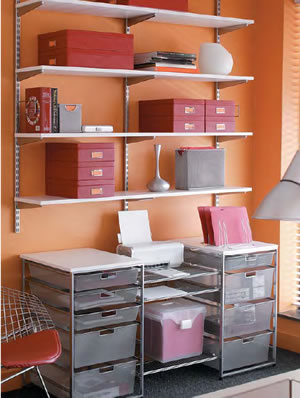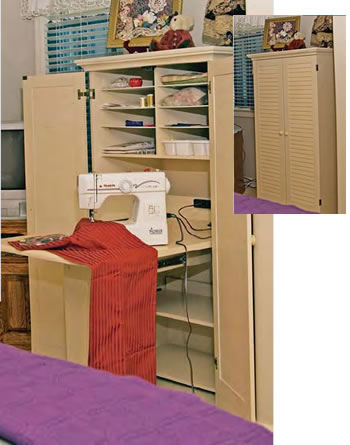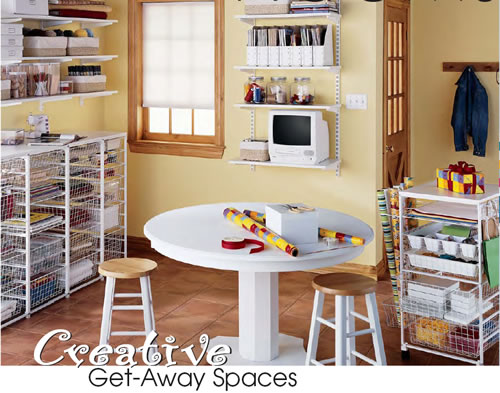Tips for Creating a Hobby Room in Your House
Creative Get-Away Spaces
You’ve probably heard the saying, “I’m not messy – I’m creative.” You may have said it yourself, but, imagine a home without interesting piles here and there. Imagine a home with a well-laid out hobby room.
Hobby rooms come in different shapes, sizes and locations. They are common in finished lower levels, bonus rooms over garages and converted bedrooms (especially in empty nester homes). Oversized laundry room/craft studios are a relatively new phenomenon that is also catching on. In many homes, hobby rooms serve a dual purpose, as in the combination office/hobby room or guest room/hobby room. Where no other space is available, a converted closet can become an efficient hobby space.
BUILT-INS
There are many factors that determine the best design for the space. If you plan to stay in your home for an extended time, special built-ins may be the best option. Because this is a permanent arrangement, it ’s important to carefully plan how you want the room laid out. For sewing, quilting, scrapbooking and crafts, activity centers in an L-, T- or U-shaped configuration will probably be more efficient than a single, straight-line surface. These arrangements can also accommodate more than one person, in case you like to work alongside a friend or family member.
Consider each activity you will be doing and the tools and supplies you will need for each. For instance, for sewing and quilting you will need a cutting table or island (ideally with fabric storage underneath), a sewing machine station with room for threads and bobbins and an ironing board. A bulletin board can offer a convenient way to post pattern instructions. Hand finishing will be much nicer with an easy chair and a lamp on top of a small chest for scissors, needles and gauge tools.
“You may want to vary the heights of your work surfaces, ”advises Design Basics Custom Home Designer Carl Cuozzo. “Thirty-six inches is the norm for work you ’ll be doing while standing; 30-32 inches is preferable if you ’ll be sitting down. ”
Built-ins don ’t necessarily have to be custom made. Two base cabinets can be placed back to back to create an island wide enough to lay out 60-inch wide fabric folded in half. Kitchen cabinets are generally 36 inches high; bath vanities are typically 32-33 inches. If a cabinet is still too tall to be comfortable, a few inches can be cut off the toe-kick space.
CASUAL, OPEN STORAGE
Some crafters and scrapbookers prefer to have their tools and supplies visible, with open wall shelving for fabric, paper supplies and clear plastic tubs with smaller items.
“There are so many organizational products available,” notes Grant Gribble of Gribble Interior Group in Orlando and a national spokesperson for the American Society of Interior Designers.
“You can get specialized storage items at hobby stores, pick up nuts and bolt containers from a home improvement store, try a tackle box from a sporting store or shop online at www.TheContainerStore.com or www.WestElm.com for larger shelving units.
“In order to work most efficiently, arrange tools and supplies in the order you plan to use them and label tubs and bins with samples or with a label maker. If you participate in quilting or scrapbooking groups, make sure you have at least one unit that’s easy to transport.”
“In a designated hobby room, you have the luxury of ‘climbing the walls,’” adds Cuozzo. “A peg board framed with molding and painted to match the walls keeps tools in easy reach and a magnetic board holds clips with fabric swatches or paper scraps – without inflicting pin holes. Vinyl-coated grid systems can support hooks for hanging, baskets, clips and racks. Another option is the type of slat wall system used by retailers (available through display houses).”

Orange walls and red containers create a lively,
playful room. Photo courtesy of The Container Store.
HOBBY SPACES IN OTHER ROOMS
Some extra ingenuity may be necessary to create a hobby room that doubles as a welcoming guest room. A built-in wall bed, bookcase and sewing armoire combination can make the most use of space and present a stylish, streamlined appearance.
“A nice, uncluttered desk is something a guest may also enjoy, ” Gribble observes. “A wood filing cabinet or a small chest with drawers can be used for a night stand. You might find some unique furnishings that add warmth and character at antique shops, office super stores or second hand office furnishing stores.
“For instance, an old library card catalog file would work well for spools of thread, buttons and other sewing notions. An architect ’s drawing cabinet ’s thin drawers could offer accessible storage for craft tools and supplies. The small drawers in an old dental cabinet would accommodate trinkets and stamps for scrapbooking. Antique printer ’s drawers can be hung on the wall for thread or stamps.”
“Purchasing an organized closet system with shelves and drawers is a practical storage solution, ” suggests Cuozzo, “since most guests don ’t stay long enough to need much closet space. Sewers and quilters may hang fabric and a rotary cutting mat from hangers.
“An armoire can look at home in a dining room, where you could use the table as a temporary work space. Sauder makes an armoire with a pull-out work surface that ’s designed for sewing, crafts or scrapbooking and keeps clutter out of sight.
“In a large shared room, a wall divider can be constructed with a bookcase on one side and a craft or sewing center on the other side.”

This trim sewing armoire keeps projects out of sight when guests are expected. Photos by Raymond Andreski.
MAXIMIZING SMALL SPACES
Done right, a reach-in closet can become an efficient hobby space. Sliding doors should be replaced with bi-fold or swinging doors to keep side walls accessible for pegboard. A counter across the back of the closet with storage underneath and shallow shelves above it can provide a work space and a fair amount of storage. The back of a swing door can also be utilized by attaching a dowel system for lengths of fabric or spools of ribbon or a swing-down table. (Make sure the table is mounted above the inside countertop so the door will close.)
Still other possibilities include a wide linen closet, a pocket office or a butler ’s pantry.
LAST, BUT NOT LEAST
To ensure your hobby room is a place you love to be, paint the walls a color that nourishes your spirit – whether it’s an energizing orange or a soothing blue or something in between.
Make sure you have adequate natural, ambient and task lighting. Halogen bulbs provide the truest color rendering, followed by incandescent. If you prefer to use fluorescent bulbs, but you require true color rendering, choose a bulb with a color rendering index (CRI) around 80 and a Kelvin temperature around 2700.
Choose easy-care flooring. For designated hobby rooms, vinyl may be the simplest. In shared rooms, low-pile carpet will be easiest to vacuum, retrieve dropped pins and roll a chair across. Small threads and paper snips can settle in grout lines in tile flooring and dropped pins may scratch wood floors.
Finally, provide some form of entertainment – a stereo and/or a television with a DVD player. Once you’ve created the ideal room, you can get started on countless other creations!


